Article Review: Multicultural Australia & Parent-Child Relationships
VerifiedAdded on 2022/08/23
|9
|2162
|15
Report
AI Summary
This article review examines the study by Lin, X., Bryant, C., Boldero, J., & Dow, B. (2017) which investigates the relationships of older Chinese immigrants with their adult children and compares them to Australian-born individuals, utilizing the solidarity-conflict model and ambivalence as frameworks. The research, based on standardized interviews with 122 community-dwelling participants aged 65 or older, reveals significant differences. Findings indicate that Chinese immigrants are more likely to live with their children, reflecting filial piety, but also exhibit lower consensual and affectual solidarity and higher conflict compared to Australian-born individuals. The review critiques the study's methodology, audience, argument, support for arguments, logical flow and relevance. It also provides a synthesis of the study's findings and its contributions to understanding the evolving dynamics of parent-child relationships in multicultural contexts, particularly in the context of aged care provision. The review also considers the study's limitations and its relevance to current research in the field and also presents the different arguments made by different researchers in the field.
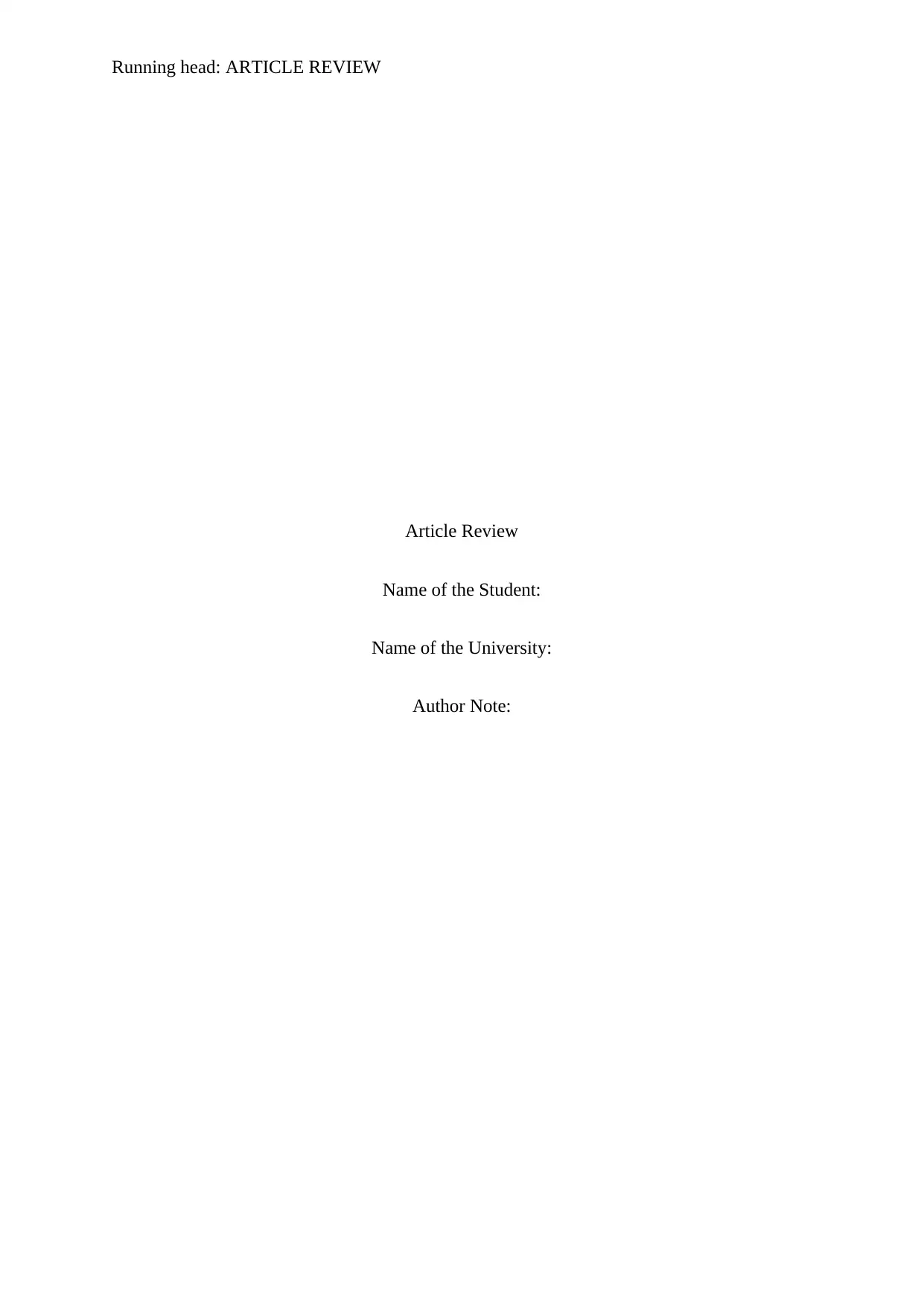
Running head: ARTICLE REVIEW
Article Review
Name of the Student:
Name of the University:
Author Note:
Article Review
Name of the Student:
Name of the University:
Author Note:
Secure Best Marks with AI Grader
Need help grading? Try our AI Grader for instant feedback on your assignments.
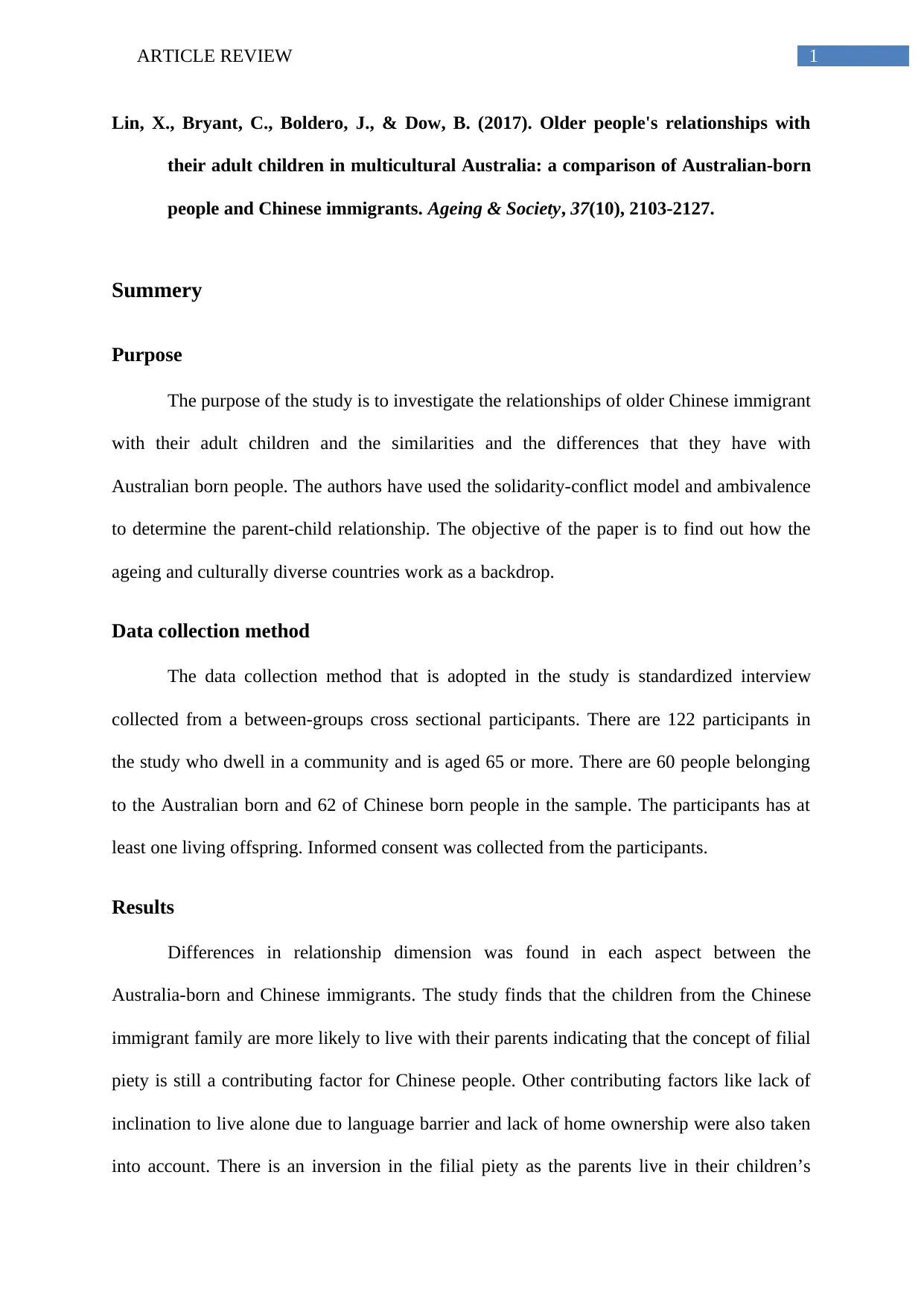
1ARTICLE REVIEW
Lin, X., Bryant, C., Boldero, J., & Dow, B. (2017). Older people's relationships with
their adult children in multicultural Australia: a comparison of Australian-born
people and Chinese immigrants. Ageing & Society, 37(10), 2103-2127.
Summery
Purpose
The purpose of the study is to investigate the relationships of older Chinese immigrant
with their adult children and the similarities and the differences that they have with
Australian born people. The authors have used the solidarity-conflict model and ambivalence
to determine the parent-child relationship. The objective of the paper is to find out how the
ageing and culturally diverse countries work as a backdrop.
Data collection method
The data collection method that is adopted in the study is standardized interview
collected from a between-groups cross sectional participants. There are 122 participants in
the study who dwell in a community and is aged 65 or more. There are 60 people belonging
to the Australian born and 62 of Chinese born people in the sample. The participants has at
least one living offspring. Informed consent was collected from the participants.
Results
Differences in relationship dimension was found in each aspect between the
Australia-born and Chinese immigrants. The study finds that the children from the Chinese
immigrant family are more likely to live with their parents indicating that the concept of filial
piety is still a contributing factor for Chinese people. Other contributing factors like lack of
inclination to live alone due to language barrier and lack of home ownership were also taken
into account. There is an inversion in the filial piety as the parents live in their children’s
Lin, X., Bryant, C., Boldero, J., & Dow, B. (2017). Older people's relationships with
their adult children in multicultural Australia: a comparison of Australian-born
people and Chinese immigrants. Ageing & Society, 37(10), 2103-2127.
Summery
Purpose
The purpose of the study is to investigate the relationships of older Chinese immigrant
with their adult children and the similarities and the differences that they have with
Australian born people. The authors have used the solidarity-conflict model and ambivalence
to determine the parent-child relationship. The objective of the paper is to find out how the
ageing and culturally diverse countries work as a backdrop.
Data collection method
The data collection method that is adopted in the study is standardized interview
collected from a between-groups cross sectional participants. There are 122 participants in
the study who dwell in a community and is aged 65 or more. There are 60 people belonging
to the Australian born and 62 of Chinese born people in the sample. The participants has at
least one living offspring. Informed consent was collected from the participants.
Results
Differences in relationship dimension was found in each aspect between the
Australia-born and Chinese immigrants. The study finds that the children from the Chinese
immigrant family are more likely to live with their parents indicating that the concept of filial
piety is still a contributing factor for Chinese people. Other contributing factors like lack of
inclination to live alone due to language barrier and lack of home ownership were also taken
into account. There is an inversion in the filial piety as the parents live in their children’s
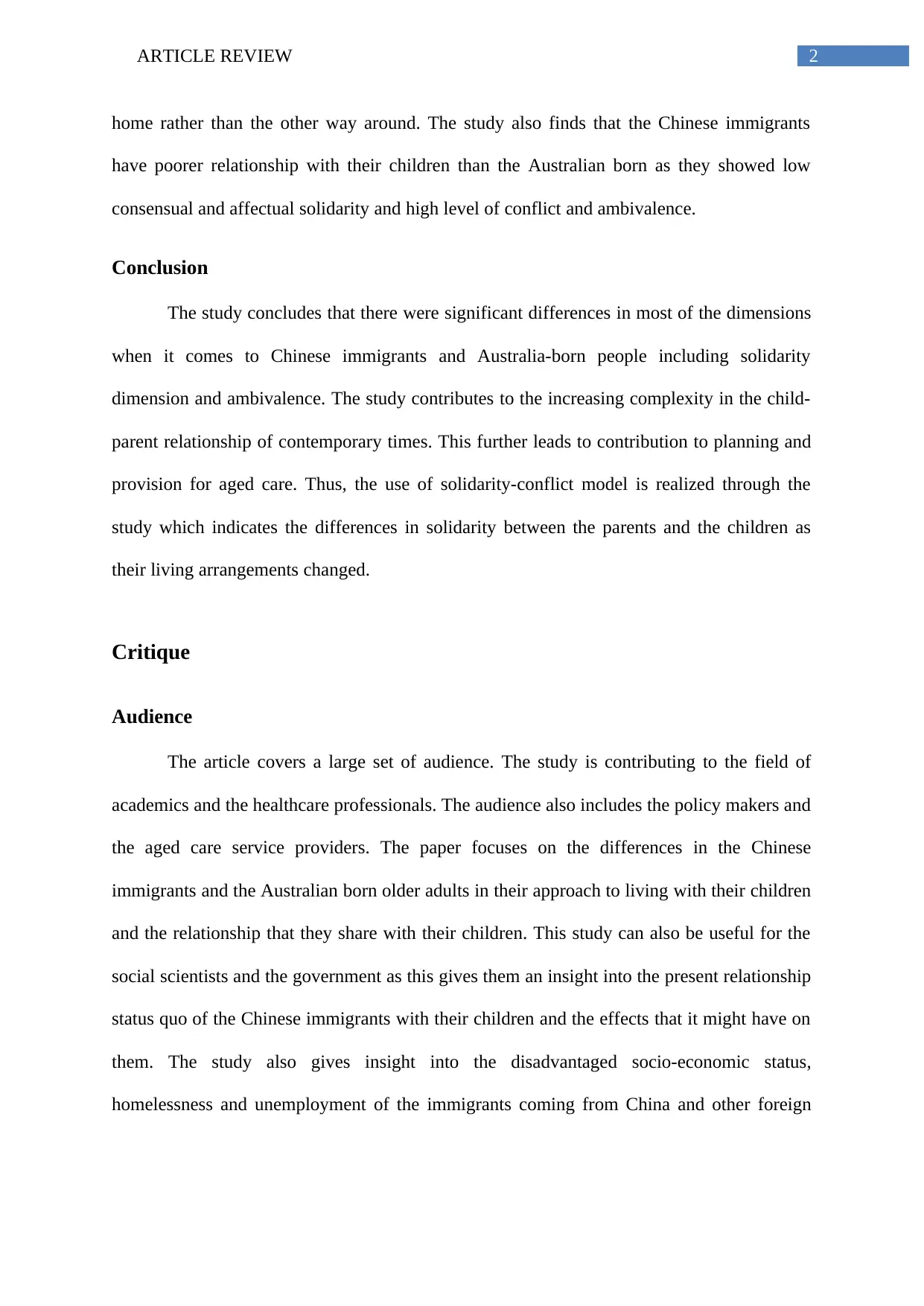
2ARTICLE REVIEW
home rather than the other way around. The study also finds that the Chinese immigrants
have poorer relationship with their children than the Australian born as they showed low
consensual and affectual solidarity and high level of conflict and ambivalence.
Conclusion
The study concludes that there were significant differences in most of the dimensions
when it comes to Chinese immigrants and Australia-born people including solidarity
dimension and ambivalence. The study contributes to the increasing complexity in the child-
parent relationship of contemporary times. This further leads to contribution to planning and
provision for aged care. Thus, the use of solidarity-conflict model is realized through the
study which indicates the differences in solidarity between the parents and the children as
their living arrangements changed.
Critique
Audience
The article covers a large set of audience. The study is contributing to the field of
academics and the healthcare professionals. The audience also includes the policy makers and
the aged care service providers. The paper focuses on the differences in the Chinese
immigrants and the Australian born older adults in their approach to living with their children
and the relationship that they share with their children. This study can also be useful for the
social scientists and the government as this gives them an insight into the present relationship
status quo of the Chinese immigrants with their children and the effects that it might have on
them. The study also gives insight into the disadvantaged socio-economic status,
homelessness and unemployment of the immigrants coming from China and other foreign
home rather than the other way around. The study also finds that the Chinese immigrants
have poorer relationship with their children than the Australian born as they showed low
consensual and affectual solidarity and high level of conflict and ambivalence.
Conclusion
The study concludes that there were significant differences in most of the dimensions
when it comes to Chinese immigrants and Australia-born people including solidarity
dimension and ambivalence. The study contributes to the increasing complexity in the child-
parent relationship of contemporary times. This further leads to contribution to planning and
provision for aged care. Thus, the use of solidarity-conflict model is realized through the
study which indicates the differences in solidarity between the parents and the children as
their living arrangements changed.
Critique
Audience
The article covers a large set of audience. The study is contributing to the field of
academics and the healthcare professionals. The audience also includes the policy makers and
the aged care service providers. The paper focuses on the differences in the Chinese
immigrants and the Australian born older adults in their approach to living with their children
and the relationship that they share with their children. This study can also be useful for the
social scientists and the government as this gives them an insight into the present relationship
status quo of the Chinese immigrants with their children and the effects that it might have on
them. The study also gives insight into the disadvantaged socio-economic status,
homelessness and unemployment of the immigrants coming from China and other foreign
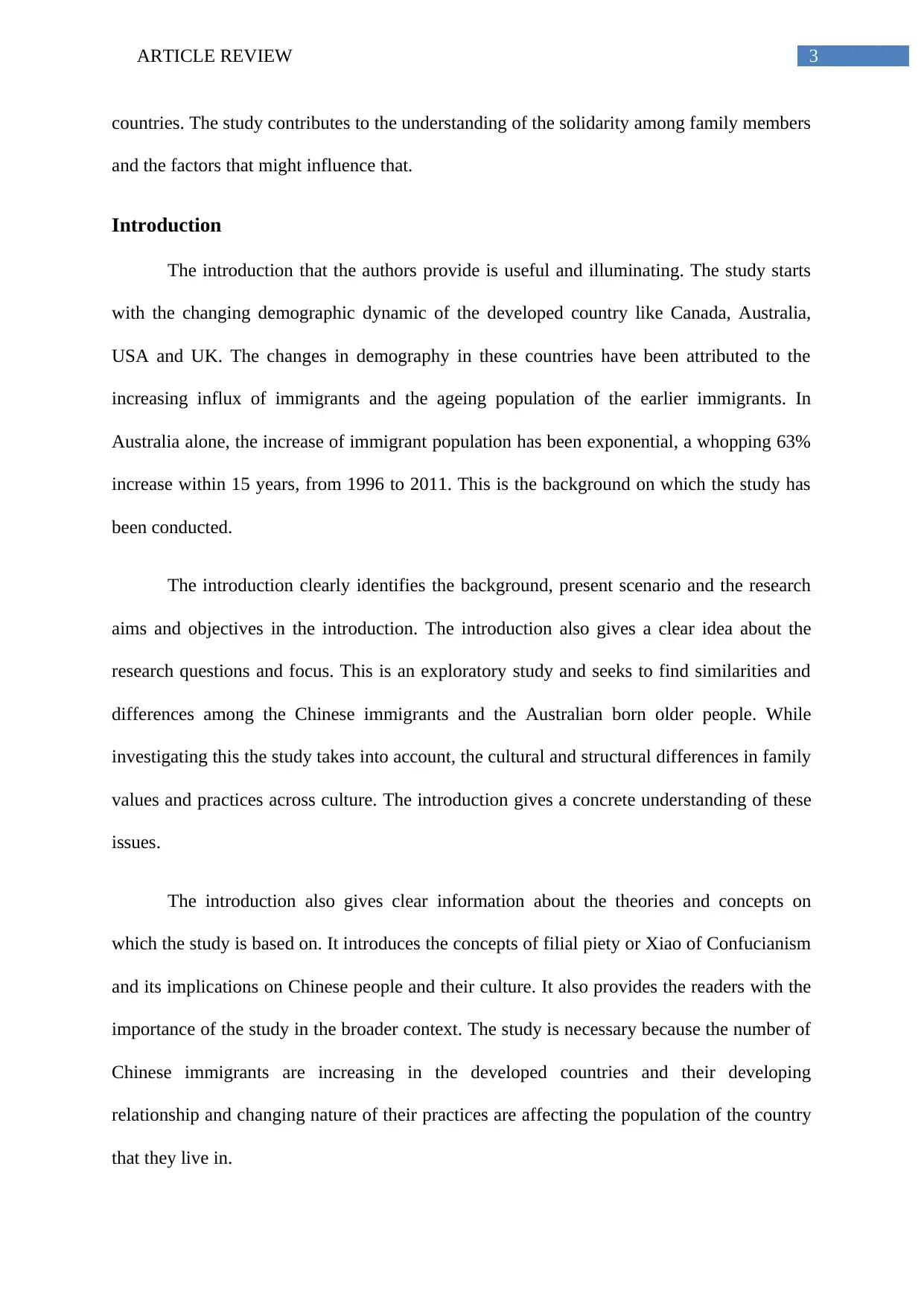
3ARTICLE REVIEW
countries. The study contributes to the understanding of the solidarity among family members
and the factors that might influence that.
Introduction
The introduction that the authors provide is useful and illuminating. The study starts
with the changing demographic dynamic of the developed country like Canada, Australia,
USA and UK. The changes in demography in these countries have been attributed to the
increasing influx of immigrants and the ageing population of the earlier immigrants. In
Australia alone, the increase of immigrant population has been exponential, a whopping 63%
increase within 15 years, from 1996 to 2011. This is the background on which the study has
been conducted.
The introduction clearly identifies the background, present scenario and the research
aims and objectives in the introduction. The introduction also gives a clear idea about the
research questions and focus. This is an exploratory study and seeks to find similarities and
differences among the Chinese immigrants and the Australian born older people. While
investigating this the study takes into account, the cultural and structural differences in family
values and practices across culture. The introduction gives a concrete understanding of these
issues.
The introduction also gives clear information about the theories and concepts on
which the study is based on. It introduces the concepts of filial piety or Xiao of Confucianism
and its implications on Chinese people and their culture. It also provides the readers with the
importance of the study in the broader context. The study is necessary because the number of
Chinese immigrants are increasing in the developed countries and their developing
relationship and changing nature of their practices are affecting the population of the country
that they live in.
countries. The study contributes to the understanding of the solidarity among family members
and the factors that might influence that.
Introduction
The introduction that the authors provide is useful and illuminating. The study starts
with the changing demographic dynamic of the developed country like Canada, Australia,
USA and UK. The changes in demography in these countries have been attributed to the
increasing influx of immigrants and the ageing population of the earlier immigrants. In
Australia alone, the increase of immigrant population has been exponential, a whopping 63%
increase within 15 years, from 1996 to 2011. This is the background on which the study has
been conducted.
The introduction clearly identifies the background, present scenario and the research
aims and objectives in the introduction. The introduction also gives a clear idea about the
research questions and focus. This is an exploratory study and seeks to find similarities and
differences among the Chinese immigrants and the Australian born older people. While
investigating this the study takes into account, the cultural and structural differences in family
values and practices across culture. The introduction gives a concrete understanding of these
issues.
The introduction also gives clear information about the theories and concepts on
which the study is based on. It introduces the concepts of filial piety or Xiao of Confucianism
and its implications on Chinese people and their culture. It also provides the readers with the
importance of the study in the broader context. The study is necessary because the number of
Chinese immigrants are increasing in the developed countries and their developing
relationship and changing nature of their practices are affecting the population of the country
that they live in.
Secure Best Marks with AI Grader
Need help grading? Try our AI Grader for instant feedback on your assignments.
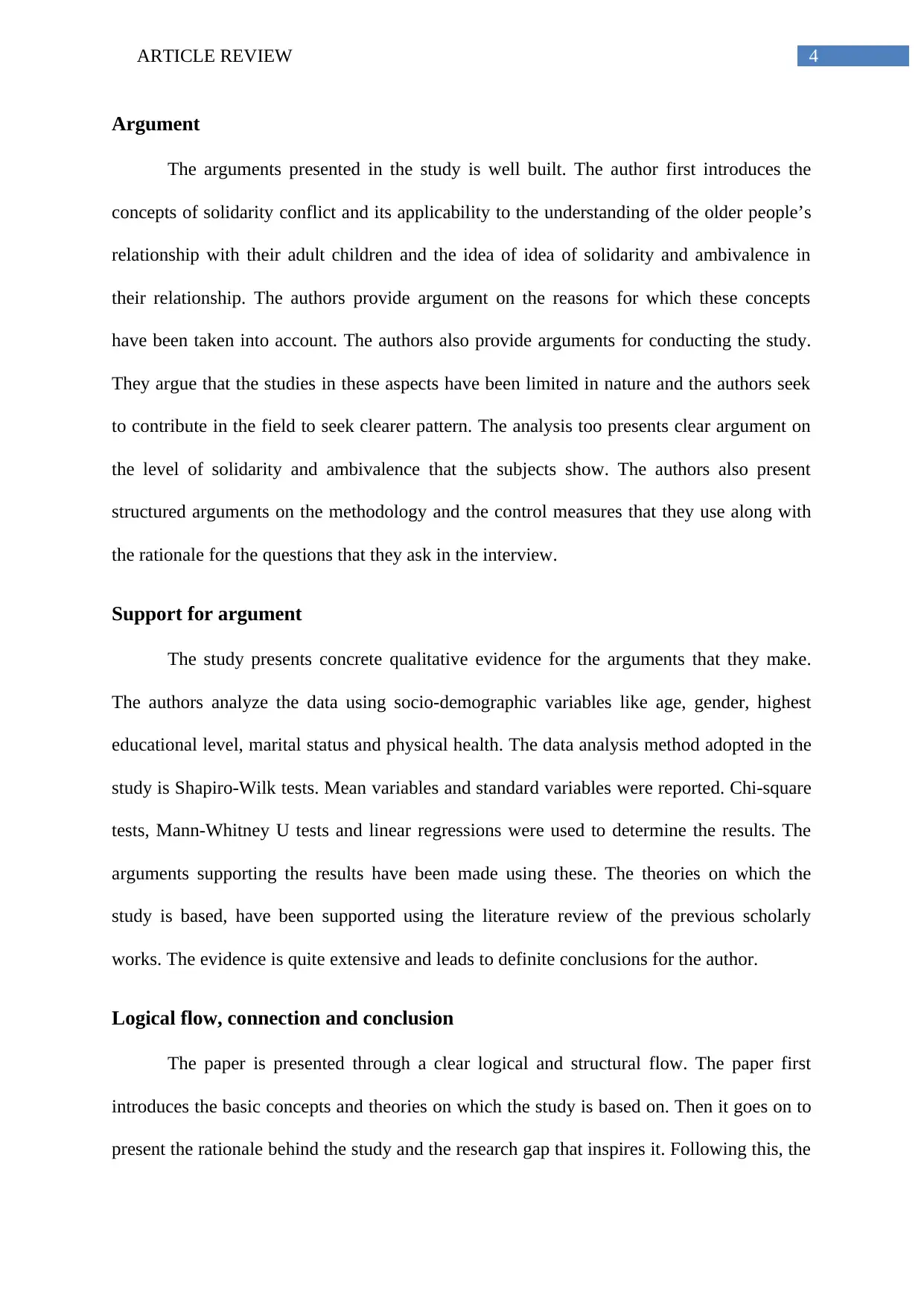
4ARTICLE REVIEW
Argument
The arguments presented in the study is well built. The author first introduces the
concepts of solidarity conflict and its applicability to the understanding of the older people’s
relationship with their adult children and the idea of idea of solidarity and ambivalence in
their relationship. The authors provide argument on the reasons for which these concepts
have been taken into account. The authors also provide arguments for conducting the study.
They argue that the studies in these aspects have been limited in nature and the authors seek
to contribute in the field to seek clearer pattern. The analysis too presents clear argument on
the level of solidarity and ambivalence that the subjects show. The authors also present
structured arguments on the methodology and the control measures that they use along with
the rationale for the questions that they ask in the interview.
Support for argument
The study presents concrete qualitative evidence for the arguments that they make.
The authors analyze the data using socio-demographic variables like age, gender, highest
educational level, marital status and physical health. The data analysis method adopted in the
study is Shapiro-Wilk tests. Mean variables and standard variables were reported. Chi-square
tests, Mann-Whitney U tests and linear regressions were used to determine the results. The
arguments supporting the results have been made using these. The theories on which the
study is based, have been supported using the literature review of the previous scholarly
works. The evidence is quite extensive and leads to definite conclusions for the author.
Logical flow, connection and conclusion
The paper is presented through a clear logical and structural flow. The paper first
introduces the basic concepts and theories on which the study is based on. Then it goes on to
present the rationale behind the study and the research gap that inspires it. Following this, the
Argument
The arguments presented in the study is well built. The author first introduces the
concepts of solidarity conflict and its applicability to the understanding of the older people’s
relationship with their adult children and the idea of idea of solidarity and ambivalence in
their relationship. The authors provide argument on the reasons for which these concepts
have been taken into account. The authors also provide arguments for conducting the study.
They argue that the studies in these aspects have been limited in nature and the authors seek
to contribute in the field to seek clearer pattern. The analysis too presents clear argument on
the level of solidarity and ambivalence that the subjects show. The authors also present
structured arguments on the methodology and the control measures that they use along with
the rationale for the questions that they ask in the interview.
Support for argument
The study presents concrete qualitative evidence for the arguments that they make.
The authors analyze the data using socio-demographic variables like age, gender, highest
educational level, marital status and physical health. The data analysis method adopted in the
study is Shapiro-Wilk tests. Mean variables and standard variables were reported. Chi-square
tests, Mann-Whitney U tests and linear regressions were used to determine the results. The
arguments supporting the results have been made using these. The theories on which the
study is based, have been supported using the literature review of the previous scholarly
works. The evidence is quite extensive and leads to definite conclusions for the author.
Logical flow, connection and conclusion
The paper is presented through a clear logical and structural flow. The paper first
introduces the basic concepts and theories on which the study is based on. Then it goes on to
present the rationale behind the study and the research gap that inspires it. Following this, the
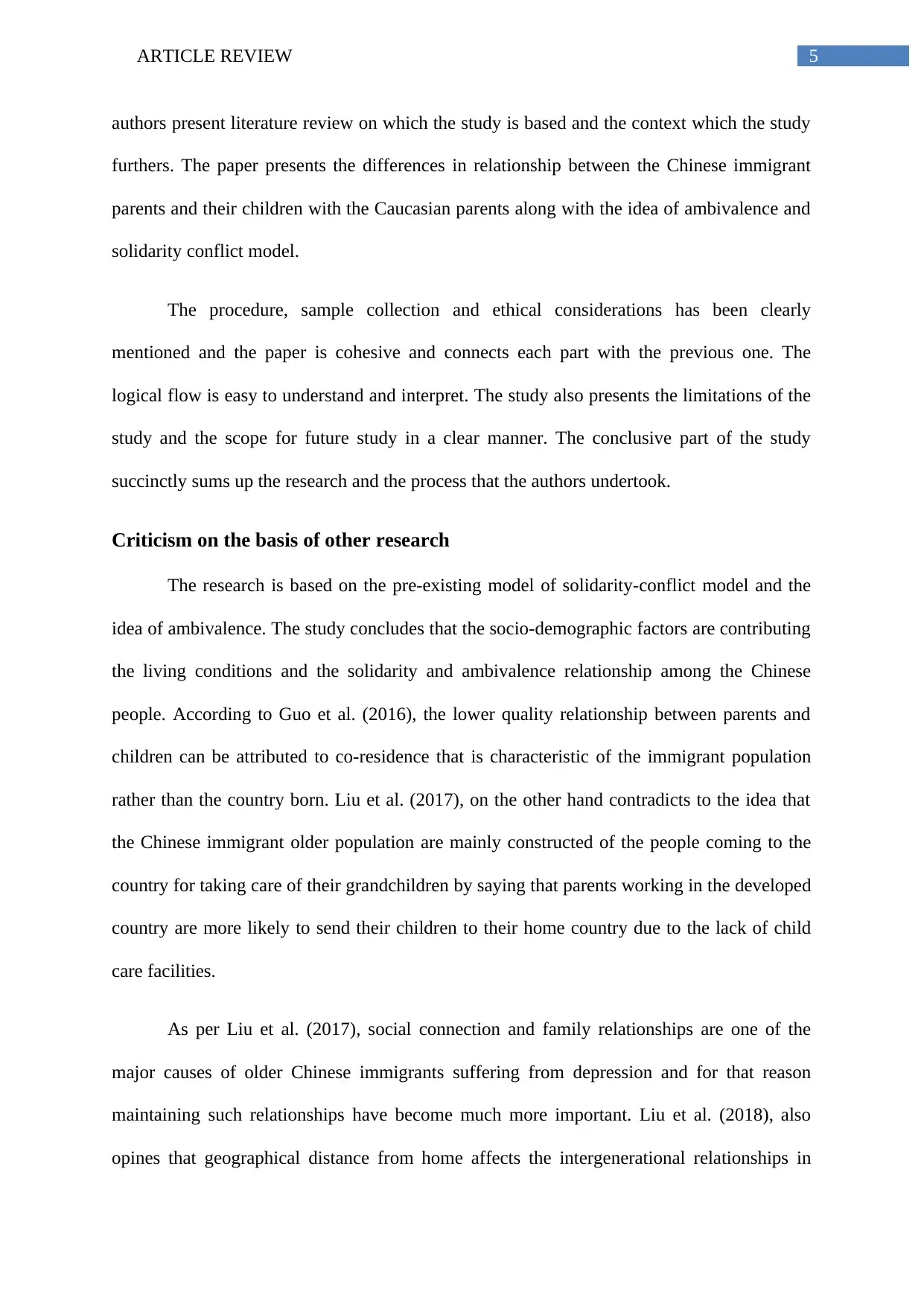
5ARTICLE REVIEW
authors present literature review on which the study is based and the context which the study
furthers. The paper presents the differences in relationship between the Chinese immigrant
parents and their children with the Caucasian parents along with the idea of ambivalence and
solidarity conflict model.
The procedure, sample collection and ethical considerations has been clearly
mentioned and the paper is cohesive and connects each part with the previous one. The
logical flow is easy to understand and interpret. The study also presents the limitations of the
study and the scope for future study in a clear manner. The conclusive part of the study
succinctly sums up the research and the process that the authors undertook.
Criticism on the basis of other research
The research is based on the pre-existing model of solidarity-conflict model and the
idea of ambivalence. The study concludes that the socio-demographic factors are contributing
the living conditions and the solidarity and ambivalence relationship among the Chinese
people. According to Guo et al. (2016), the lower quality relationship between parents and
children can be attributed to co-residence that is characteristic of the immigrant population
rather than the country born. Liu et al. (2017), on the other hand contradicts to the idea that
the Chinese immigrant older population are mainly constructed of the people coming to the
country for taking care of their grandchildren by saying that parents working in the developed
country are more likely to send their children to their home country due to the lack of child
care facilities.
As per Liu et al. (2017), social connection and family relationships are one of the
major causes of older Chinese immigrants suffering from depression and for that reason
maintaining such relationships have become much more important. Liu et al. (2018), also
opines that geographical distance from home affects the intergenerational relationships in
authors present literature review on which the study is based and the context which the study
furthers. The paper presents the differences in relationship between the Chinese immigrant
parents and their children with the Caucasian parents along with the idea of ambivalence and
solidarity conflict model.
The procedure, sample collection and ethical considerations has been clearly
mentioned and the paper is cohesive and connects each part with the previous one. The
logical flow is easy to understand and interpret. The study also presents the limitations of the
study and the scope for future study in a clear manner. The conclusive part of the study
succinctly sums up the research and the process that the authors undertook.
Criticism on the basis of other research
The research is based on the pre-existing model of solidarity-conflict model and the
idea of ambivalence. The study concludes that the socio-demographic factors are contributing
the living conditions and the solidarity and ambivalence relationship among the Chinese
people. According to Guo et al. (2016), the lower quality relationship between parents and
children can be attributed to co-residence that is characteristic of the immigrant population
rather than the country born. Liu et al. (2017), on the other hand contradicts to the idea that
the Chinese immigrant older population are mainly constructed of the people coming to the
country for taking care of their grandchildren by saying that parents working in the developed
country are more likely to send their children to their home country due to the lack of child
care facilities.
As per Liu et al. (2017), social connection and family relationships are one of the
major causes of older Chinese immigrants suffering from depression and for that reason
maintaining such relationships have become much more important. Liu et al. (2018), also
opines that geographical distance from home affects the intergenerational relationships in
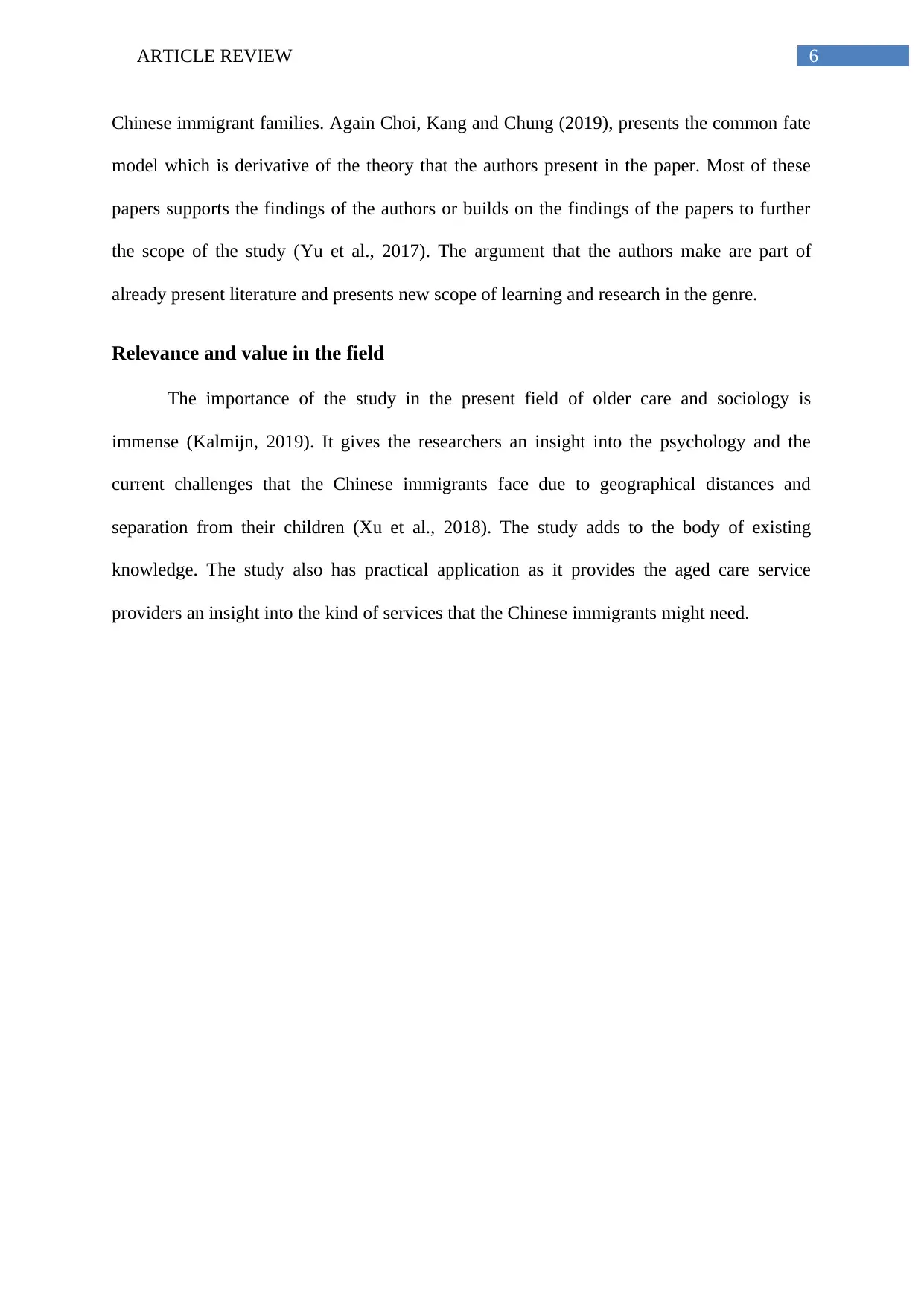
6ARTICLE REVIEW
Chinese immigrant families. Again Choi, Kang and Chung (2019), presents the common fate
model which is derivative of the theory that the authors present in the paper. Most of these
papers supports the findings of the authors or builds on the findings of the papers to further
the scope of the study (Yu et al., 2017). The argument that the authors make are part of
already present literature and presents new scope of learning and research in the genre.
Relevance and value in the field
The importance of the study in the present field of older care and sociology is
immense (Kalmijn, 2019). It gives the researchers an insight into the psychology and the
current challenges that the Chinese immigrants face due to geographical distances and
separation from their children (Xu et al., 2018). The study adds to the body of existing
knowledge. The study also has practical application as it provides the aged care service
providers an insight into the kind of services that the Chinese immigrants might need.
Chinese immigrant families. Again Choi, Kang and Chung (2019), presents the common fate
model which is derivative of the theory that the authors present in the paper. Most of these
papers supports the findings of the authors or builds on the findings of the papers to further
the scope of the study (Yu et al., 2017). The argument that the authors make are part of
already present literature and presents new scope of learning and research in the genre.
Relevance and value in the field
The importance of the study in the present field of older care and sociology is
immense (Kalmijn, 2019). It gives the researchers an insight into the psychology and the
current challenges that the Chinese immigrants face due to geographical distances and
separation from their children (Xu et al., 2018). The study adds to the body of existing
knowledge. The study also has practical application as it provides the aged care service
providers an insight into the kind of services that the Chinese immigrants might need.
Paraphrase This Document
Need a fresh take? Get an instant paraphrase of this document with our AI Paraphraser
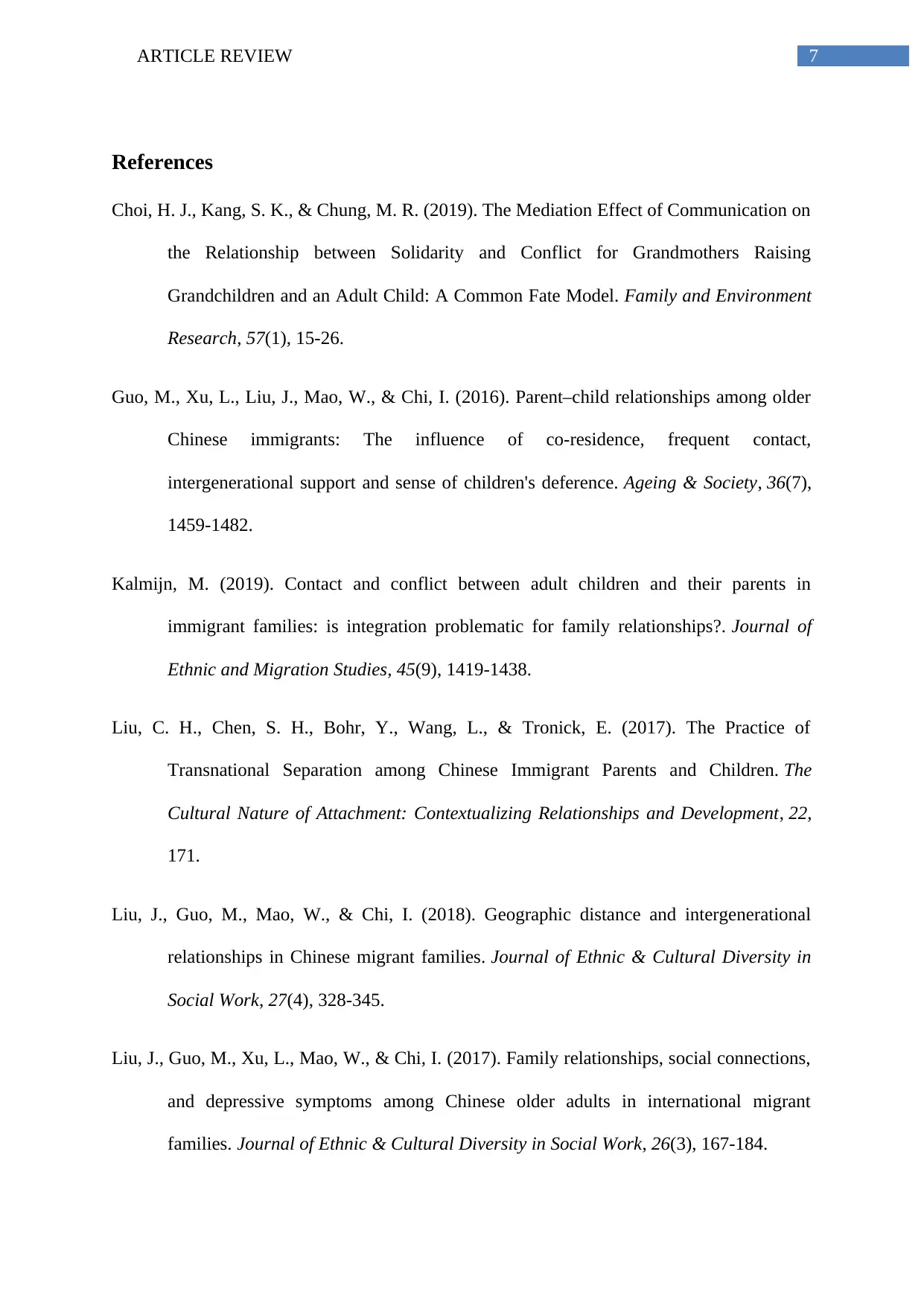
7ARTICLE REVIEW
References
Choi, H. J., Kang, S. K., & Chung, M. R. (2019). The Mediation Effect of Communication on
the Relationship between Solidarity and Conflict for Grandmothers Raising
Grandchildren and an Adult Child: A Common Fate Model. Family and Environment
Research, 57(1), 15-26.
Guo, M., Xu, L., Liu, J., Mao, W., & Chi, I. (2016). Parent–child relationships among older
Chinese immigrants: The influence of co-residence, frequent contact,
intergenerational support and sense of children's deference. Ageing & Society, 36(7),
1459-1482.
Kalmijn, M. (2019). Contact and conflict between adult children and their parents in
immigrant families: is integration problematic for family relationships?. Journal of
Ethnic and Migration Studies, 45(9), 1419-1438.
Liu, C. H., Chen, S. H., Bohr, Y., Wang, L., & Tronick, E. (2017). The Practice of
Transnational Separation among Chinese Immigrant Parents and Children. The
Cultural Nature of Attachment: Contextualizing Relationships and Development, 22,
171.
Liu, J., Guo, M., Mao, W., & Chi, I. (2018). Geographic distance and intergenerational
relationships in Chinese migrant families. Journal of Ethnic & Cultural Diversity in
Social Work, 27(4), 328-345.
Liu, J., Guo, M., Xu, L., Mao, W., & Chi, I. (2017). Family relationships, social connections,
and depressive symptoms among Chinese older adults in international migrant
families. Journal of Ethnic & Cultural Diversity in Social Work, 26(3), 167-184.
References
Choi, H. J., Kang, S. K., & Chung, M. R. (2019). The Mediation Effect of Communication on
the Relationship between Solidarity and Conflict for Grandmothers Raising
Grandchildren and an Adult Child: A Common Fate Model. Family and Environment
Research, 57(1), 15-26.
Guo, M., Xu, L., Liu, J., Mao, W., & Chi, I. (2016). Parent–child relationships among older
Chinese immigrants: The influence of co-residence, frequent contact,
intergenerational support and sense of children's deference. Ageing & Society, 36(7),
1459-1482.
Kalmijn, M. (2019). Contact and conflict between adult children and their parents in
immigrant families: is integration problematic for family relationships?. Journal of
Ethnic and Migration Studies, 45(9), 1419-1438.
Liu, C. H., Chen, S. H., Bohr, Y., Wang, L., & Tronick, E. (2017). The Practice of
Transnational Separation among Chinese Immigrant Parents and Children. The
Cultural Nature of Attachment: Contextualizing Relationships and Development, 22,
171.
Liu, J., Guo, M., Mao, W., & Chi, I. (2018). Geographic distance and intergenerational
relationships in Chinese migrant families. Journal of Ethnic & Cultural Diversity in
Social Work, 27(4), 328-345.
Liu, J., Guo, M., Xu, L., Mao, W., & Chi, I. (2017). Family relationships, social connections,
and depressive symptoms among Chinese older adults in international migrant
families. Journal of Ethnic & Cultural Diversity in Social Work, 26(3), 167-184.
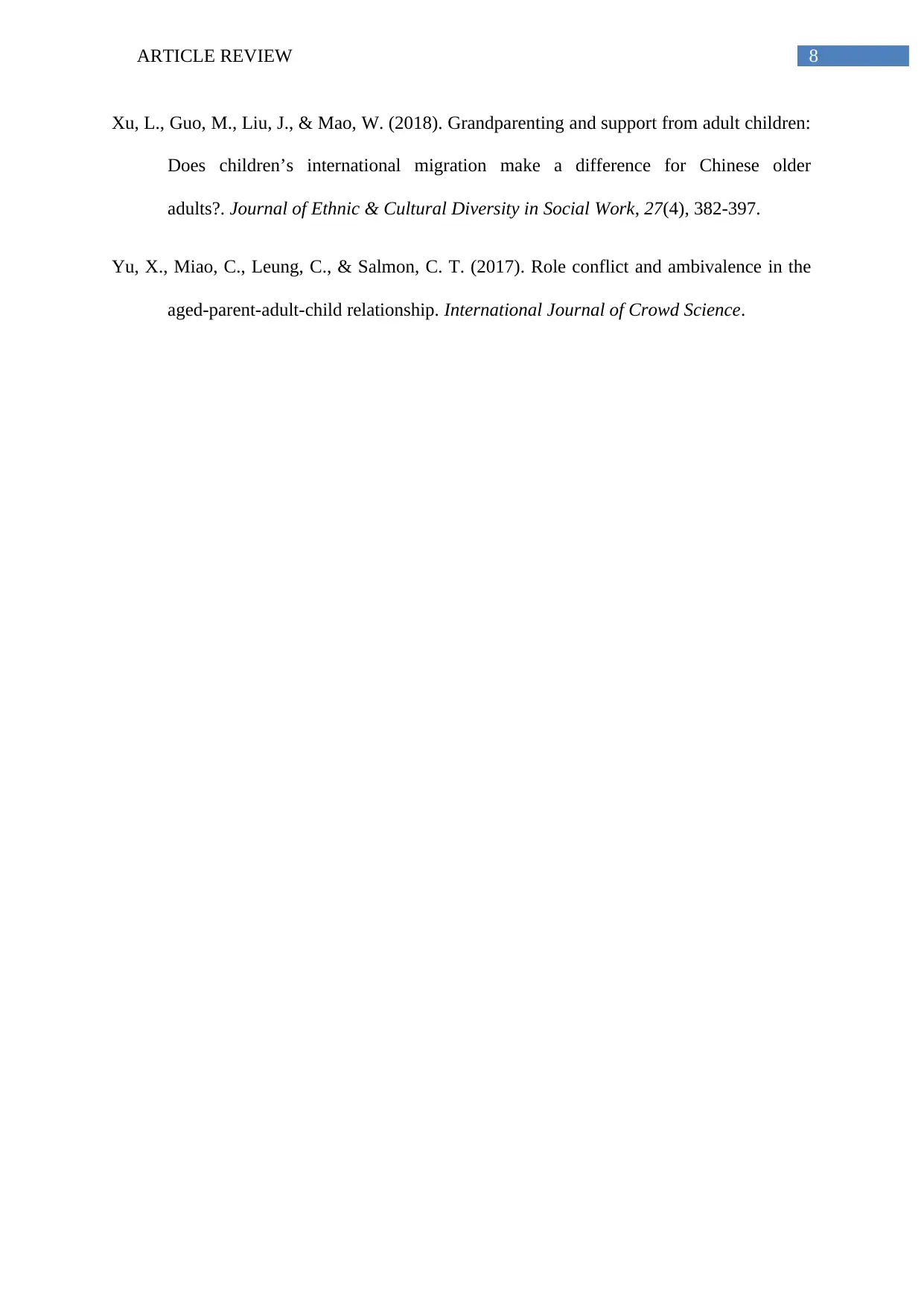
8ARTICLE REVIEW
Xu, L., Guo, M., Liu, J., & Mao, W. (2018). Grandparenting and support from adult children:
Does children’s international migration make a difference for Chinese older
adults?. Journal of Ethnic & Cultural Diversity in Social Work, 27(4), 382-397.
Yu, X., Miao, C., Leung, C., & Salmon, C. T. (2017). Role conflict and ambivalence in the
aged-parent-adult-child relationship. International Journal of Crowd Science.
Xu, L., Guo, M., Liu, J., & Mao, W. (2018). Grandparenting and support from adult children:
Does children’s international migration make a difference for Chinese older
adults?. Journal of Ethnic & Cultural Diversity in Social Work, 27(4), 382-397.
Yu, X., Miao, C., Leung, C., & Salmon, C. T. (2017). Role conflict and ambivalence in the
aged-parent-adult-child relationship. International Journal of Crowd Science.
1 out of 9
Your All-in-One AI-Powered Toolkit for Academic Success.
+13062052269
info@desklib.com
Available 24*7 on WhatsApp / Email
![[object Object]](/_next/static/media/star-bottom.7253800d.svg)
Unlock your academic potential
© 2024 | Zucol Services PVT LTD | All rights reserved.

